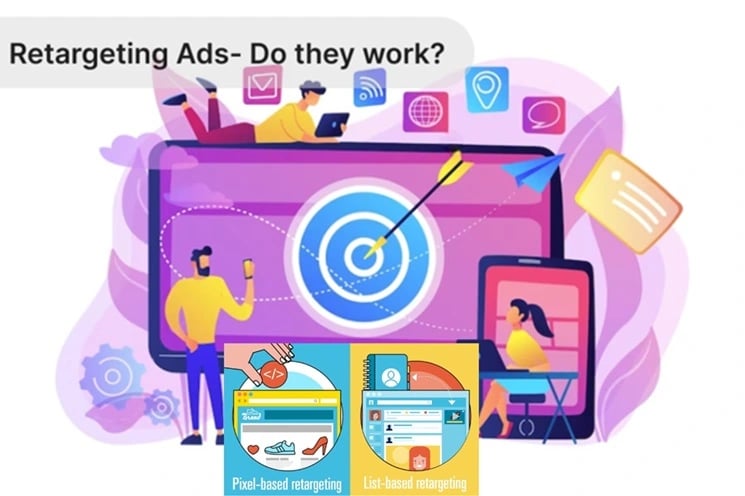
Just like remarketing, retargeting ads are crucial for reconnecting with potential customers who have shown interest in your business but haven’t converted yet. This ultimate guide covers the basics of retargeting campaigns, including pixel-based and list-based approaches, types of campaigns such as email, mobile app, search, social media, and website retargeting. If you want to probe deeper into the world of retargeting, learn how to set up a successful retargeting campaign to increase brand awareness, reduce cart abandonment, and boost conversion rates for your website and business.
Types of Retargeting
The table below outlines the two main types of retargeting: Pixel-Based Retargeting and List-Based Retargeting.

| Pixel-Based Retargeting | List-Based Retargeting |
| Targets visitors who left your website before completing a purchase | Uses your existing contact list to reach potential customers |
| Involves pixel tracking on your website to serve targeted ads | Requires uploading email addresses to your retargeting platform |
| Offers timely ad delivery after visitors leave your site | Customizable based on your contact list and browsing history |
| Effective for smaller volumes but specific targeting | Requires maintaining and updating your contact list |
Pixel-Based Retargeting
Retargeting through pixel-based approaches allows you to re-engage with website visitors who showed interest but didn’t convert. By utilizing a JavaScript pixel code on relevant pages, you can track visitor behavior and trigger personalized ads based on their interactions. This method offers the benefit of immediate action upon a user leaving the site, capturing their interest effectively.
List-Based Retargeting
Types of retargeting campaign can utilize your existing contact list to establish connections with potential customers. By uploading email addresses to your retargeting platform, you can reach a broader audience based on their browsing history and preferences. List-based retargeting enables personalized ads and a higher level of customization, targeting individuals likely to revisit your website. Knowing how to segment your contact list is crucial for the success of this method in reaching specific audience segments.
Goals of Retargeting Campaigns
Increase Brand Awareness
One way to utilize retargeting campaigns is to enhance brand awareness. By showing personalized ads to potential customers who have interacted with your website but have not converted yet, you can keep your brand at the forefront of their minds. The more exposure a customer has to your brand through retargeted ads, the more likely they are to consider your business when making a purchase decision. This strategy is based on the marketing rule of seven, which suggests that consumers need multiple touchpoints with a brand before making a purchase.
Reduce Cart Abandonment
For businesses looking to decrease cart abandonment rates, retargeting campaigns can be a powerful tool. When a customer adds products to their shopping cart but leaves the website without completing the purchase, personalized retargeted ads can remind them to return and finalize the transaction. By offering discounts or special incentives in these ads, you can entice customers back to your website and increase conversion rates. This strategy can help recover potentially lost sales and improve customer lifetime value by nurturing leads that might have otherwise slipped away.
Retargeting plays a crucial role in reducing cart abandonment rates by re-engaging customers who showed initial interest in your products or services but didn’t follow through with a purchase. Through targeted ads that remind customers of their abandoned carts, businesses can recover potentially lost sales and improve overall conversion rates.
Boost Conversion Rates
Boosting conversion rates is a key objective of retargeting campaigns. By bringing back website visitors who didn’t convert during their initial visit, these campaigns increase the likelihood of those visitors turning into customers. Statistics show that website visitors are 70% more likely to convert on a retailer’s site when retargeted with ads after leaving a page. In addition to increasing sales, retargeting can also improve other key metrics like click-through rates and lead capture form completions. Taking a comprehensive approach to retargeting can lead to significant improvements in overall conversion rates for your business.
Understanding the goals of a retargeting campaign and selecting the appropriate strategies based on those objectives play a crucial role in ensuring its success. By implementing a combination of retargeting methods like email, mobile app, search, social media, and website retargeting, businesses can optimize their digital marketing efforts to convert more customers and enhance their online presence.
Types of Retargeting Campaigns

Once again, there are various types of retargeting campaigns that businesses can utilize to reach their target audience and achieve specific marketing goals. These campaigns include:
| Email Retargeting | Mobile App Retargeting |
| Search Retargeting | Social Media Retargeting |
| Website Retargeting |
Email Retargeting
To effectively re-engage potential customers who have shared their contact information but have not completed a purchase, businesses can implement an email retargeting campaign. This strategy allows personalized ads to be sent via email, targeting specific audience segments based on their browsing history and interactions with the business. By leveraging tools like Mailchimp, HubSpot, and Klaviyo, companies can drive leads and enhance brand trust through tailored messaging.
Assume that maintaining an updated contact list is important for the success of an email retargeting campaign. By consistently refining and segmenting the contact database, businesses can ensure that the right messages are reaching the right audiences, ultimately boosting conversion rates and customer retention.
Mobile App Retargeting
With a mobile app retargeting campaign, businesses can re-engage individuals who have shown interest in their app but have not yet completed the desired actions, such as downloading or using the app. This approach helps remind users of the app’s value and functionality, encouraging them to revisit and engage with the app to drive conversions and user retention.
Assume that personalized and timely notifications play a crucial role in the effectiveness of mobile app retargeting campaigns. By delivering impactful messages that resonate with users’ needs and preferences, businesses can increase app usage and loyalty, leading to long-term customer relationships.
Search Retargeting
Mobile app retargeting campaigns enable companies to reconnect with users who have abandoned their app by reminding them of its unique benefits and encouraging continued engagement.
Retargeting ads on mobile apps can significantly increase user retention rates and drive conversions, ultimately increasing revenue and customer lifetime value as users become more engaged with the app over time.
Social Media Retargeting
Retargeting on social media platforms allows businesses to reach individuals who have expressed interest in their products or services but have not yet made a purchase. By delivering targeted ads on platforms like Facebook and Instagram, companies can maintain brand visibility, drive website traffic, and convert leads into customers.
Plus, leveraging video-based ads on platforms such as YouTube enables businesses to create engaging, dynamic content that captures users’ attention and encourages them to take action. By utilizing social media retargeting effectively, companies can maximize the impact of their digital marketing efforts and foster meaningful connections with their target audience.
Website Retargeting
One of the most common types of retargeting campaigns, website retargeting focuses on reconnecting with visitors who have shown interest in a business’s products or services but have not completed a purchase. By displaying personalized ads on other websites that these visitors subsequently browse, businesses can keep their brand top of mind and encourage return visits and conversions.
Another benefit of website retargeting is the ability to tailor ads based on visitors’ browsing behavior, offering relevant products or services that align with their interests. This personalized approach can lead to higher engagement rates and improved conversion outcomes for businesses seeking to drive sales and increase customer loyalty.
How to Set Up a Retargeting Campaign

Identify Your Goals to Create a Retargeting Strategy
Now, it’s time to identify your goals for setting up a retargeting campaign. Any successful campaign starts with a clear understanding of what you want to achieve. Do you aim to drive more website traffic, increase business leads, or convert more customers? By defining your goals, you can tailor your retargeting strategy to reach the desired outcome.
Determine Your Budget & Choose a Retargeting Platform
Identify your budget for the retargeting campaign and select a suitable platform based on your goals and targeted audience. To effectively reach your customers and generate leads, you must allocate the appropriate funds to your campaign. Choose a platform like Google Ads, Facebook Ads, or Instagram that aligns with your campaign’s objectives and allows you to segment your audience for personalized ads.
To ensure your retargeting efforts are optimized for success, it’s necessary to allocate your budget wisely and choose a platform that maximizes your reach. By selecting the right platform and optimizing your budget, you can enhance the effectiveness of your retargeting campaign and increase the chances of converting leads into customers.
Create and Optimize Your Ad
On the chosen retargeting platform, create compelling and optimized ads that resonate with your audience. Craft actionable ad copy, use visually appealing elements, and include clear calls to action to prompt engagement. Tailor your ad content to match the interests and preferences of your target audience based on collected data to maximize the impact of your retargeting efforts.
Another key aspect of creating successful retargeting ads is to ensure they are optimized for delivery and performance. By using features offered by platforms like Facebook Ads that allow for audience segmentation and ad delivery optimization, you can increase the chances of your ads reaching the right customers at the right time, leading to higher engagement and conversion rates.
Track the Results of Your Campaign
With your retargeting campaign in motion, track necessary metrics like cost per lead (CPL), click-through rate (CTR), and cost per click (CPC) to measure the campaign’s performance. Analyzing these results allows you to refine your strategies, reallocate your budget, and optimize your ads for better outcomes. By continuously monitoring and analyzing the data, you can make informed decisions to enhance the effectiveness of your retargeting campaign.
With the ability to track and analyze campaign results, you have valuable insights that can help you make data-driven decisions and optimize your retargeting efforts for better outcomes. By leveraging the data collected from your campaign, you can refine your strategies, improve ad performance, and achieve your business goals more effectively.
Benefits of Retargeting
Despite the challenges businesses face in converting website visitors into customers, retargeting ads offer a valuable solution. By reconnecting with potential customers who have shown interest but haven’t converted yet, businesses can significantly improve their sales and customer lifetime value.
Increase Sales and Customer Lifetime Value
An effective retargeting campaign can increase sales by capturing the attention of potential customers who have already interacted with a business. For instance, website visitors are 70% more likely to convert on a retailer’s site when retargeted with ads after leaving a page. By leveraging personalized ads, businesses can re-engage these visitors, leading to higher conversion rates and ultimately boosting their revenue.
Common Retargeting Mistakes to Avoid
For businesses looking to make the most out of their retargeting campaigns and convert more customers, it’s important to steer clear of common mistakes that can hinder your success. By avoiding these pitfalls, you can optimize your retargeting strategy for better results.
One common mistake to avoid is neglecting to set clear goals for your retargeting campaign. Without defined objectives, it can be challenging to tailor your ads to the right audience or measure the success of your efforts. Before launching a retargeting campaign, take the time to identify specific goals, whether it’s increasing brand awareness, reducing cart abandonment, or boosting conversion rates.
Another mistake to watch out for is relying solely on one type of retargeting campaign. While pixel-based retargeting may work well for some businesses, others may benefit more from list-based retargeting. By diversifying your retargeting efforts and exploring different campaign types like email, mobile app, search, social media, and website retargeting, you can reach a wider audience and maximize your results.
It’s also crucial to avoid bombarding your audience with too many retargeting ads. While the goal is to stay top of mind with potential customers, overwhelming them with excessive ads can lead to ad fatigue and turn them off from your brand. Instead, focus on delivering tailored, timely ads that provide value and entice customers to revisit your website.
Lastly, don’t forget to track and analyze the results of your retargeting campaign. Monitoring key metrics like cost per lead, click-through rate, and conversion rates can help you understand what’s working and what needs adjustment. By continuously optimizing your ads based on data-driven insights, you can ensure your retargeting efforts are driving the desired outcomes for your business.
Avoiding these common retargeting mistakes can help you create more effective campaigns that resonate with your audience and drive conversions. By setting clear goals, diversifying your campaign types, pacing your ads appropriately, and analyzing results, you can maximize the impact of your retargeting strategy and convert more customers for your business.
Conclusion
Following this comprehensive guide to retargeting ads, businesses can effectively re-engage website visitors and turn them into valuable customers. By implementing pixel-based and list-based retargeting approaches, businesses can create personalized ad campaigns to increase brand awareness, reduce cart abandonment, and boost conversion rates. With various types of retargeting campaigns available, such as email, mobile app, search, social media, and website retargeting, businesses can choose the strategies that best fit their goals and audience. Setting up a retargeting campaign involves identifying goals, setting a budget, choosing a platform, creating and optimizing ads, and tracking results to continuously improve campaign performance and maximize ROI. Utilizing retargeting ads can help businesses increase sales, improve customer lifetime value, and establish a strong online presence.
For businesses looking to enhance their online presence, increase customer engagement, and convert more leads, retargeting ads offer a powerful tool to connect with potential customers at various stages of the buyer’s journey. By following the steps outlined in this guide and leveraging the expertise of professionals, businesses can optimize their retargeting campaigns and achieve their desired outcomes. With a focus on website design, customer conversion, brand reputation, and social media engagement, businesses can leverage retargeting ads to attract and retain customers effectively. Don’t miss out on the opportunity to enhance your online presence and drive conversions with strategic retargeting campaigns tailored to your business needs.











